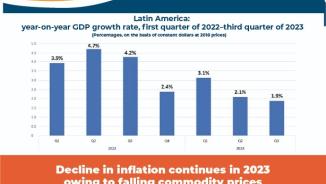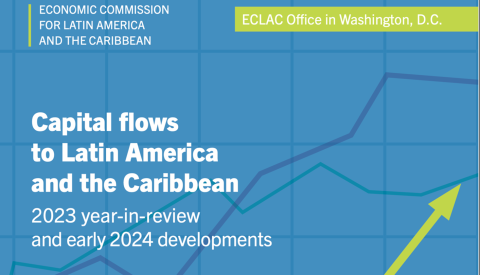infographic
Market sentiment and portfolio flows to Latin America and the Caribbean (LAC) ended the first quarter of 2016 on a more optimistic note than it started, with new bond issuance reaching almost 14 billion dollars in March, the highest monthly issuance since June 2014, according to the report Capital Flows to Latin America and the Caribbean: Q1 2016, released by the Washington Office of the Economic Commission for Latin America and the Caribbean (ECLAC).
According to this study, there was a large rally in LAC assets in March, but its intensity was also a function of the very challenging start of the year. The main threats of the beginning of the year –higher U.S. interest rates, further oil-price declines and a Chinese economic slump– had receded by the end of the quarter.
Monetary easing by major central banks, a firming of commodity prices, and increasing confidence that the U.S. Federal Reserve was not planning to raise interest rates again, powered stocks and bonds higher.
The document highlights that the first quarter of 2016 was thus a tale of two halves. Latin American stocks gained almost 19% in the first quarter, according to the MSCI Latin American Index, erasing in March most of the decline they sustained during the selloff at the start of the year.
Currencies also came back from recent lows against the U.S. dollar. LAC bond spreads tightened by 32 basis points in the first quarter of 2016, following a widening of almost 100 basis points in 2015. The report reflects that, after peaking in January, the U.S. dollar moderated against major currencies, supporting the tightening in spreads.
Heightened market volatility in the early part of the first quarter made issuance difficult for even the best rated issuers, but a strong rally in March made for better issuance conditions. While new bond issuance reached almost 14 billion dollars in that month, total LAC debt issuance reached 29.76 billion dollars in the first quarter of 2016, compared to 30.54 billion dollars in the same period in 2015, 3% lower.
But it was a big improvement from the 18.10 billion dollars issued in the whole second half of 2015 (there was a considerable slowdown in LAC debt issuance from July to December 2015, as volatility and lower commodity prices loomed over the region). For an overview of the main trends of 2015, see Capital Flows to Latin America and the Caribbean: 2015 Overview.
Breaking with recent trends, sovereigns had the highest share of total issuance (53%), while corporates (47%) had their lowest share of the total since 2005, according to the document Capital Flows to Latin America and the Caribbean: Q1 2016.
It notes that issuance by banks and corporates in the first quarter of 2016 was 16% lower than in the first quarter of 2015 and 69% lower than in the first quarter of 2014. The increase in sovereigns’ share of total issuance took place despite concerns over their credit ratings. There were nine negative sovereign credit rating actions during the first quarter and only two positive actions.
Despite the improved sentiment at the end of the quarter, the external environment remains challenging. The study concludes that crude oil prices, the Chinese economy, the real impact of negative rates on the European system and, particularly, the future trajectory of the U.S. monetary policy remain as question marks, and a gradual increase in U.S. interest rates may take the shine off the recent rebound in LAC financial assets.

